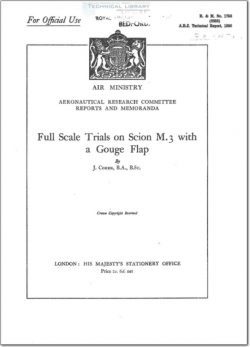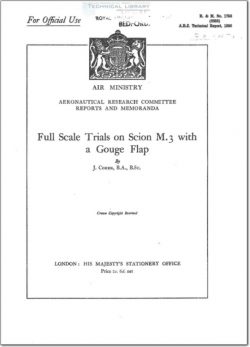ARC-RM-1753

- Version
- 201 Downloads
- 2.26 MB File Size
- 1 File Count
- June 16, 2016 Create Date
- June 16, 2016 Last Updated
Full Scale Trials on Scion M.3 with a Gouge Flap

SUMMARY. Introductory (Purpose of Investigation).—~—The Scion is a twin—
engined, high wing monoplane of 3,000 lb. maximum weight with a 46 per cent.
span Gouge flap. The changes in the aerodynamic characteristics, take—off and
landing qualities, caused by the flap, were required.
Range of Investigation—Lift, drag, gliding angle and attitude curves were
determined with flaps closed and open. Take—offs and landings with the flap
Closed, half and fully open, were analysed from cinematograph pictures. The
effect of the’ flap on stability and control was found qualitatively.
C0%clusions.——The flap increases CL max. from 1~17T to 1-65 both at or 2 16°
(approx.) and reduces the stalling speed from 66 to 56 mph. for a mean weight
of 2,750 lb. The flap reduces the total drag at a given speed for speeds less
than 85 mph. but the flap profile drag coefficient is about 0-03.
The flap decreases the minimum gliding angle from 7% to 7°. To trim at constant
speed, when the flap is opened, the elevator has to be moved down about 7° to
correct tail heaviness, and the attitude is changed —-6°.
The flap half and fully open decreases the distance from rest to take-off by
14 per cent. and 23 per cent., and also decreases the distance from take-off to
clear a 50 ft. obstacle by 21 per cent. and 23 per cent. respectively. The speed
at take—off is reduced by 3 and 8 mph. respectively. These same flap positions
for landing increase the distance from a 50 ft. obstacle to touch by 10 per cent.
and 7 per cent, decrease the distance from touch to rest by 27 per cent. and
34 per cent. and reduce the total distance by 13 per cent. and 18 per cent. ; the
touch speed is reduced by 6 and 9 mph. respectively. The flap effect quickly
falls. off after the half open position.
Lateral stability, which is poor near the stall, is improved when the flap is open,
the ailerons becoming more positive. The elevator is affected adversely, and the
rudder which near the stall is weak, is unaffected by the flap; there is a trace
of buffeting with flap open.
| File | Action |
|---|---|
| ARC-RM-1753 Full Scale Trials on Scion M.3 with a Gouge Flap.pdf | Download |
Comment On This Post